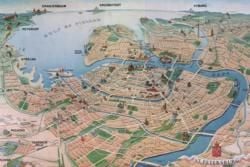St Petersburg Regional Overview
Introduction
"He stood on the banks of the deserted waters, full of profound thoughts, and stared into the distance". And this is how, according to Russia’s greatest poet Aleksandr Pushkin, Peter the Great decided by royal decree to create the capital of his empire, St Petersburg, on the boggy land lining the Baltic Sea. An architectural gem of global significance, the city was constructed along canals lined with baroque palaces, broad avenues, parks, theaters and churches, a window onto Europe for the great Russian hinterland and a sign to the world that Russia had arrived as a modern global power.
Rising out of the shallow waters and Baltic mists, St Petersburg retains something of the unreal about it to this day. Over the course of 300 years, following three name changes, several revolutions, a brutal blockade and the removal of its capital status, the city has witnessed more history than cities several times as old – Romanovs and Revolutionaries, mystics and musicians, artists and writers, poets and ballerinas – all have made this city their home and been inspired by the unique cityscape and its cultured and discerning inhabitants.
Geography
The city sits just below the 60th parallel north of the equator, making it by far the largest city located this far north. It lies at the extreme eastern edge of the Baltic Sea between it and the inland Lake Ladoga, where the Neva River empties into the sea. The exact location was chosen by Peter the Great both to defend against the Swedes, and because he believed Ladoga would be a perfect place to build ships (later abandoned and moved to the area of today’s Admiralty). The first construction took place at the site of what is today the Peter and Paul Fortress, on a small island attached to Petrogradskaya. From there the city expanded outwards across Petrogradskaya, and only later onto the mainland.
Contemporary city
Today a city of almost 5 million people and the country’s ‘northern capital’, it has shaken off the lawless image of the 1990s, its native sons are once again ruling Russia, and global treasures such as the Hermitage and Russian Museum and Mariinsky Theater (home to the Kirov Ballet Company) are among Europe’s most prominent cultural attractions. In spite of its unrivalled place in Russia’s cultural history (as well as Pushkin, the city was variously home to Gogol, Dostoevsky, Tchaikovksy, Shostakovich, Akhmatova, Rimsky-Korsakov, and many others), the city refuses to rest on its historical laurels. With its palaces turned into museums and galleries, its theaters restored to former glories, old warehouses converted into art venues and new bars, restaurants and shopping opportunities springing up all the time, there is a sense that St Petersburg’s best days are yet to come.
Orientation
For ease of orientation, we have created several maps incorporating different areas of the city and its outskirts. If you’re walking round it may make sense to limit yourself to a different area each day of your visit, and this is the intention of the maps. The most important area for tourists is undoubtedly the Historic Center, which includes many of the most important tourist sites for visitors such as the Hermitage and Russian Museum, the Admiralty, Kazan Cathedral, St Isaac’s Cathedral and the Church of the Spilled Blood, the Mariinsky, Aleksandrinsky and Mikhailovsky theaters, the Mikhailovsky, Yusupov, and Vorontsov Palaces, the northern half of Nevsky prospekt and Gostinny Dvor. You will be sure to spend most of your time in this area. Across the Neva river are Vasilievsky ostrov, (often shortened to V.O. in addresses) where the Stock Exchange building and rostral columns are located and some great views of the Winter Palace from across the river, and Petrogradskaya, site of the Peter and Paul Fortress, Battleship Avrora, Museum of Political History, and Yelagin Palace. Further north are the Outlying Islands, Krestovksy, Kamenny, and Yelagin, with parks and green areas for walking and fresh air. To the east of the Historic Center lies the area of Chernyshevskaya, which includes the districts of Liteyny and Smolny, including Smolny Cathedral, Alexander Nevsky Monastery and Tikhvin cemetery, the Akhmatova and Blockade museums, and Sheremetev and Taurida palaces. Vyborgskaya incorporates the area lying along the northern and eastern banks of the Neva, and is where the Finland Station can be found. Vosstaniya is the area lying between the Fontanka and Obvodny canals, east of Nevsky prospekt, and includes the Dostoevsky museum. Fanning out from the center, most visitors will visit Pobeda only for Park Pobedy and on their way to and from Pulkovo airport, but this is where a lot of locals live and work and there are plenty of restaurants and shopping opportunities for the intrepid traveller to explore.
Some of St Petersburg’s most important ‘must-see’ sites are located outside the city centre, although still within the administrative confines of the city. To the west of the city these include Strelna and Lomonosov with historic palaces to visit, but none more so than Peterhof with its palace, estate, fountains and various historic buildings to visit. A couple of days out here is time well spent, and will also allow you to visit the island fortress of Kronstadt. South of the city centre there are palace estates at Gatchina, Tsarskoe Selo and Pavlovsk. Heading along the north shore west towards the Finnish border is St Petersburg’s main summer resort areas, centered around Repino, with sandy beaches and pine forests stretching down to the sea, sanatoriums and a laid back resort atmosphere which makes a complete contrast to the city.
??????????? St Petersburg Historic Centre ?? ????? ???????? ???????




